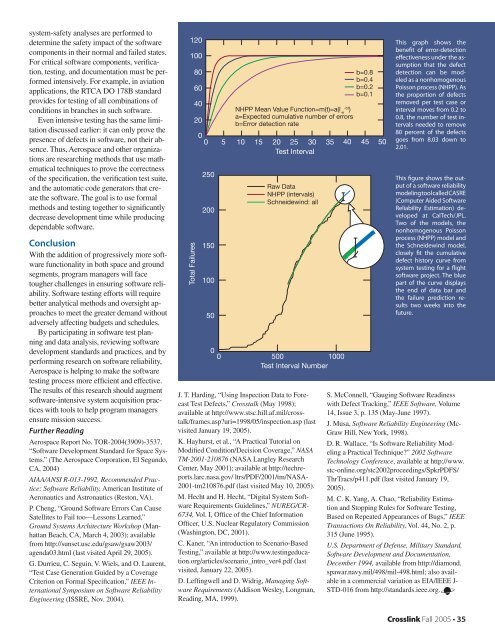A Successful Strategy for Satellite Development and Testing - Inpe
A Successful Strategy for Satellite Development and Testing - Inpe
A Successful Strategy for Satellite Development and Testing - Inpe
- No tags were found...
You also want an ePaper? Increase the reach of your titles
YUMPU automatically turns print PDFs into web optimized ePapers that Google loves.
system-safety analyses are per<strong>for</strong>med todetermine the safety impact of the softwarecomponents in their normal <strong>and</strong> failed states.For critical software components, verification,testing, <strong>and</strong> documentation must be per<strong>for</strong>medintensively. For example, in aviationapplications, the RTCA DO 178B st<strong>and</strong>ardprovides <strong>for</strong> testing of all combinations ofconditions in branches in such software.Even intensive testing has the same limitationdiscussed earlier: it can only prove thepresence of defects in software, not their absence.Thus, Aerospace <strong>and</strong> other organizationsare researching methods that use mathematicaltechniques to prove the correctnessof the specification, the verification test suite,<strong>and</strong> the automatic code generators that createthe software. The goal is to use <strong>for</strong>malmethods <strong>and</strong> testing together to significantlydecrease development time while producingdependable software.ConclusionWith the addition of progressively more softwarefunctionality in both space <strong>and</strong> groundsegments, program managers will facetougher challenges in ensuring software reliability.Software testing ef<strong>for</strong>ts will requirebetter analytical methods <strong>and</strong> oversight approachesto meet the greater dem<strong>and</strong> withoutadversely affecting budgets <strong>and</strong> schedules.By participating in software test planning<strong>and</strong> data analysis, reviewing softwaredevelopment st<strong>and</strong>ards <strong>and</strong> practices, <strong>and</strong> byper<strong>for</strong>ming research on software reliability,Aerospace is helping to make the softwaretesting process more efficient <strong>and</strong> effective.The results of this research should augmentsoftware-intensive system acquisition practiceswith tools to help program managersensure mission success.Further ReadingAerospace Report No. TOR-2004(3909)-3537,“Software <strong>Development</strong> St<strong>and</strong>ard <strong>for</strong> Space Systems.”(The Aerospace Corporation, El Segundo,CA, 2004)AIAA/ANSI R-013-1992, Recommended Practice:Software Reliability, American Institute ofAeronautics <strong>and</strong> Astronautics (Reston, VA).P. Cheng, “Ground Software Errors Can Cause<strong>Satellite</strong>s to Fail too—Lessons Learned,”Ground Systems Architecture Workshop (ManhattanBeach, CA, March 4, 2003); availablefrom http://sunset.usc.edu/gsaw/gsaw2003/agenda03.html (last visited April 29, 2005).G. Durrieu, C. Seguin, V. Wiels, <strong>and</strong> O. Laurent,“Test Case Generation Guided by a CoverageCriterion on Formal Specification,” IEEE InternationalSymposium on Software ReliabilityEngineering (ISSRE, Nov. 2004).120100Total Failures8060402000 5 10 15 20 25 30 35 40 45 50Test Interval25020015010050NHPP Mean Value Function=m(t)=a(l -e-bt)a=Expected cumulative number of errorsb=Error detection rateRaw DataNHPP (intervals)Schneidewind: all0 0 5001000Test Interval NumberJ. T. Harding, “Using Inspection Data to ForecastTest Defects,” Crosstalk (May 1998);available at http://www.stsc.hill.af.mil/crosstalk/frames.asp?uri=1998/05/inspection.asp(lastvisited January 19, 2005).K. Hayhurst, et al., “A Practical Tutorial onModified Condition/Decision Coverage,” NASATM-2001-210876 (NASA Langley ResearchCenter, May 2001); available at http://techreports.larc.nasa.gov/ltrs/PDF/2001/tm/NASA-2001-tm210876.pdf (last visited May 10, 2005).M. Hecht <strong>and</strong> H. Hecht, “Digital System SoftwareRequirements Guidelines,” NUREG/CR-6734, Vol. I, Office of the Chief In<strong>for</strong>mationOfficer, U.S. Nuclear Regulatory Commission(Washington, DC, 2001).C. Kaner, “An introduction to Scenario-Based<strong>Testing</strong>,” available at http://www.testingeducation.org/articles/scenario_intro_ver4.pdf(lastvisited, January 22, 2005).D. Leffingwell <strong>and</strong> D. Widrig, Managing SoftwareRequirements (Addison Wesley, Longman,Reading, MA, 1999).b=0.8b=0.4b=0.2b=0.1This graph shows thebenefit of error-detectioneffectiveness under the assumptionthat the defectdetection can be modeledas a nonhomogenousPoisson process (NHPP). Asthe proportion of defectsremoved per test case orinterval moves from 0.2 to0.8, the number of test intervalsneeded to remove80 percent of the defectsgoes from 8.03 down to2.01.This figure shows the outputof a software reliabilitymodeling tool called CASRE(Computer Aided SoftwareReliability Estimation) developedat CalTech/JPL.Two of the models, thenonhomogenous Poissonprocess (NHPP) model <strong>and</strong>the Schneidewind model,closely fit the cumulativedefect history curve fromsystem testing <strong>for</strong> a flightsoftware project. The bluepart of the curve displaysthe end of data bar <strong>and</strong>the failure prediction resultstwo weeks into thefuture.S. McConnell, “Gauging Software Readinesswith Defect Tracking,” IEEE Software, Volume14, Issue 3, p. 135 (May-June 1997).J. Musa, Software Reliability Engineering (Mc-Graw Hill, New York, 1998).D. R. Wallace, “Is Software Reliability Modelinga Practical Technique?” 2002 SoftwareTechnology Conference, available at http://www.stc-online.org/stc2002proceedings/SpkrPDFS/ThrTracs/p411.pdf (last visited January 19,2005).M. C. K. Yang, A. Chao, “Reliability Estimation<strong>and</strong> Stopping Rules <strong>for</strong> Software <strong>Testing</strong>,Based on Repeated Appearances of Bugs,” IEEETransactions On Reliability, Vol. 44, No. 2, p.315 (June 1995).U.S. Department of Defense, Military St<strong>and</strong>ard,Software <strong>Development</strong> <strong>and</strong> Documentation,December 1994, available from http://diamond.spawar.navy.mil/498/mil-498.html; also availablein a commercial variation as EIA/IEEE J-STD-016 from http://st<strong>and</strong>ards.ieee.org.Crosslink Fall 2005 • 35
















